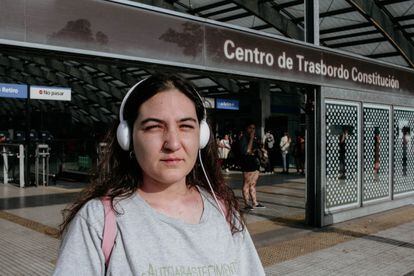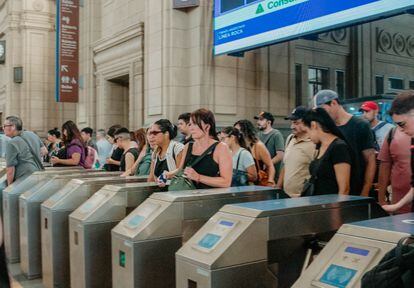The line to load the transportation card at the Constitución station, in the south of the city of Buenos Aires, is so long that passengers wait up to 20 minutes to pay. The area functions as a transfer center for passengers who enter the Argentine capital from the periphery early in the morning and leave in the afternoon. Trains, buses and the subway converge there. Normally, there are many people. But this Wednesday the line is unusual, according to passengers. Since this week the Government of Javier Milei imposed New Rates for public transport, several have run out of credit on their cards faster than usual. Rates had been frozen for months despite the increase in inflation and the sudden increase has had an impact on the users' battered economies.
Iris, 55, waits in line and holds her bag clutched to her chest. Before leaving her house, at five-thirty in the morning, she combed her black hair in a ponytail and put on her nurse's outfit: the shirt with light blue flowers and white pants. When she now approaches the ticket office, she asks the saleswoman to load her transportation card with the bills she is carrying in her hand: “2,000 pesos, please.” It is around 1.8 dollars in the dollar exchange rate blue, which Argentines buy on the parallel market. “Until last week I carried 1,000 pesos and I got ready all week. Now I have to charge every two days,” explains the woman, who prefers not to give her last name.
The Ministry of Transportation of Argentina reported that as of Tuesday the cheapest bus ticket in the capital and its periphery went from 76.9 to 270 pesos (from 0.07 to 0.2 dollars) and the train ticket, which varies Depending on the line, it went from around 48 to 130 pesos (from 0.04 to 0.1 dollars) – there is a social rate for users who need it. The increase was 250% in the first case and 170% in the second. The subway fare, set by the Government of the City of Buenos Aires and which increased previously, went from 100 to 125. Starting in April, the rates will increase even more for those who have not registered the SUBE card with their data, the plastic to pay for the tickets.
The Government's decision to increase rates for this region, where in January there were more than 10.2 million daily transfers, was agreed with the transport companies, which have long complained that they are not able to cover the costs due to the increase. of inflation and with union representatives. “We know the social impact it has [el aumento de la tarifa]but if the funds do not come through subsidies or through the tariff, a third option appears, which is the worst of all: the reduction of frequency or the paralysis of services,” warned Luciano Fusaro, vice president of the Argentine Association of Automotive Transport Entrepreneurs (AAETA), in a television interview.
Prices had a first increase in December and a second in February, which has hit travelers even more. Behind Iris, more users come to recharge their empty cards. Miriam Morel, 51, manages this Wednesday to process a disability certificate for her son and return to her house. She traveled with him 45 minutes on foot by bus from the southern outskirts of Buenos Aires, where they live, and they will walk from the station to the office to save another transportation. With what she carries now, they will be able to return after completing the procedure. “1,500 pesos,” she asks.
Florencia Aquino, who is 30 years old and works in gastronomy, charges 2,500 pesos. She has no way to save because the distances she travels are too long. She accepts the increase, but criticizes that there is no improvement in the service, which she says is “disastrous” in the periphery: only one bus takes her to the station, it is usually “full” and takes up to 40 minutes to appear on the street. stop. Behind comes Alberto Flores, a 73-year-old plumber. He is about to board the fourth transport of the morning – after the first, the fare is reduced on the following journeys – which will take him to work; The same thing happens to his partner, who is a domestic worker. The two leave their house at five twenty in the morning and meet here again at seven in the afternoon. “The purchasing power that people lost is enormous,” he says, “this is the life we live.”

The lowest rates in the country and region
Until Tuesday, rates in Buenos Aires and its periphery were the lowest in South America, according to a comparison made by the economist Rafael Skiadaressis. While in the Argentine capital you paid 0.07 dollars for a bus ticket, in Montevideo you paid 1.15 dollars, in Lima 0.92 and in San Pablo 0.89. This region also has the cheapest tickets within the country. The price that users pay to travel in the city of Córdoba, for example, is 340 pesos; in Bariloche it is 320 and in Mar del Plata it is 297, according to a relay from the Argentine Association of Automotive Transport Entrepreneurs.
This has been the case because public transport tickets throughout the country are heavily subsidized and also because the capital and its surroundings have a special compensation regime. Subsidies for public transport in Argentina were established after the 2001 crisis, when companies were on the verge of bankruptcy and users had no money to pay for trips. The new model remained in place even after the debacle, until today. With the increase in rates in Buenos Aires and its metropolitan area, the Government began to reduce the contributions that the State makes to companies that operate in this area. The Ministry of Economy also announced this week that it will eliminate the Interior Compensation Fund that was transferred to the provinces. This last decision is read in Argentina as Milei's revenge against the governors for th
e failure in Congress of the vote on his omnibus law.
When Milei arrived at the Casa Rosada, the State financed 90% of the real cost of the ticket. The Government paid in December $47.1 million in subsidies, according to the Ministry of Infrastructure. The new Executive, which took power that month, assured that it intended to gradually eliminate them in three years as part of the economic program designed by the Minister of Finance, Luis Caputo. According to the head of the economic portfolio, transport and energy subsidies represent 2% of GDP and their “correction” brings the Government closer to its goal of reducing the deficit. “It will probably take several years to finish them off.” [los subsidios]”, warned the presidential spokesman, Manuel Adorni, this week.

The new Administration also aims to make a “change of focus” in the model so that State contributions are directed towards demand and not towards supply, as is the case now. Today, the Government directly finances the companies, a model that has been questioned by some experts. A Cippec report Published in 2012 and signed by Lucio Castro and Paula Szenkman, it points out the “growing distributive inequality” and “inefficiency” of the model and suggests “the need to explore alternatives” to “direct the benefit to the segments of the population that need it most.” ”.
Among experts, there is a consensus on the revision that the subsidy system in Argentina needs. Political scientist Alejandro Rascovan, for example, believes that an entity should be created that “brings together the practice of transportation,” as exists in Paris or New York. But Rascovan proposes expanding the debate beyond the economic focus that the Government gives it. “All public transportation on the planet is deficient — there may be exceptions like Tokyo, which is a megalopolis with great purchasing power,” says the political scientist and adds: “The issue is what social role it fulfills.” “The problem is not that there are many subsidies, the problem is who distributes it, how and to whom. The system needs an overhaul, but it is unfair and a bad political decision for the debate to be about the rate. That meant that today, with a heat wave, there were lines of hundreds of people to recharge the SUBE and that the system was down,” he warns.
This Wednesday, maximums of 37 degrees are expected in Buenos Aires. After paying, Iris goes to the bus line to start her work day and visit at least three addresses. She has to continue traveling to the capital because the company she works for assigned her that position. From the municipality where she lives, she takes the train and then a bus, which she pays at a reduced rate because after the first trip, subsequent trips are charged less. But now she values “leaving work and looking for something else.” “I work to pay for the ticket,” laments the woman, who earns 1,500 pesos an hour. “I live with my husband, we both work and even that is not enough. We have our house, but we have to get dressed, put on shoes, unfortunately one gets sick and the medicines are very expensive… We knew there was going to be a huge price, but not like this,” she says.
Subscribe here to newsletter from EL PAÍS América and receive all the key information on current events in the region.
#increase #public #transportation #hits #Argentines #work #pay #ticket
